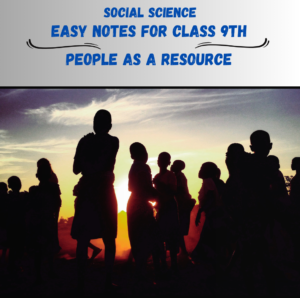- Introduction:
- Population Size and Distribution:
- Population Density:
- Understanding Population Growth:
- Processes of Population Change: Birth, Death, and Migration
- Age Composition:
Introduction:
Have you ever wondered about a world without people? Well, humans are the superheroes who make resources useful and create our social world. Dive into the exciting universe of population dynamics using India’s census -it’s like uncovering the hidden story of our country! Ready for this exploration?
Let’s first focus on three key questions about population:
- Population Size and Distribution: How many people are there, and where are they located?
- Population Growth and Processes of Change: How has the population grown and changed over time?
- Characteristics of the Population: What are their age, sex composition, literacy levels, occupational structure, and health conditions?
Population Size and Distribution:
- India’s population, as of March 2011, was 1,210.6 million, making up 17.5% of the world’s population.
- Unevenly spread across 3.28 million sq km, India’s land area is 2.4% of the world’s.
- Uttar Pradesh, with 199 million people, is the most populous state, contributing 16% to India’s total.
Population Density:
- Population density is the number of people per unit area, with India being densely populated.
- In 2011, India’s density was 382 persons per sq km, ranging from 1,102 persons in Bihar to 17 in Arunachal Pradesh.
- Factors like terrain, climate, and rainfall influence population density.
Less Populated:
- Arunachal Pradesh: 1,383,727 people.
- Sikkim: 610,577.
- Lakshadweep: Only 64,473 people.
Moderately Populated:
- Assam and most of the Peninsular states: Moderate population densities.
Densely Populated:
- Northern Plains and Kerala: High to very high population densities.
- States with population densities below 250 persons per square km (excluding those mentioned in “Less Populated”).
Most Populated (Top Five States):
- Uttar Pradesh: 199.5 million people.
- Maharashtra: 112 million
- Bihar: 10.41 million
- West Bengal: 9.13 million
- Andhra Pradesh: 84.5 milllion.
Understanding Population Growth:
Population growth refers to the change in the number of inhabitants in a specific area over a defined period. It is measured in absolute numbers and annual percentage change.
Estimates and Measurement:
- Absolute Increase:
- Calculated by subtracting the earlier population from the later population.
- Provides a tangible measure of growth in actual numbers.
- Annual Growth Rate:
- Expressed as a percentage, indicating the pace of population increase per year.
- Helps understand the momentum of growth over time.
- India’s Population Growth:
- Example of a nation with a dynamic growth trajectory.
- From 1951 to 1981, experienced steady growth; since then, growth rates have declined.
- Challenges of Large Populations:
- Countries with significant populations face challenges even with lower growth rates.
- Total additions to the population can still be substantial.
- Future Projections:
- Ongoing estimates predict the potential course of population growth.
- India, for example, may surpass China as the most populous country in the future.
Factors Influencing Population Growth:
- Births:
- The number of new individuals entering the population through childbirth.
- High birth rates contribute to population growth.
- Deaths:
- The number of individuals leaving the population due to mortality.
- Low death rates can contribute to population growth.
- Migrations:
Processes of Population Change: Birth, Death, and Migration
Core Processes:
- Natural Increase: Population growth depends on the difference between births and deaths.
- Birth Rate’s Role: The number of live births per thousand people, or birth rate, significantly influences growth, particularly in India.
- Decline in Death Rates: Until 1980, lower death rates played a crucial role in India’s rapid population growth.
- Changes Since 1981: After 1981, a gradual decline in birth rates has slowed overall population growth.
Migration’s Impact:
Migration: The movement of people within or between areas, plays a vital role in population dynamics.
Two types of Migration:
- Internal:
- Internal migration influences the distribution of population without changing the total population size.
- International:
- Whereas, International Migration causes the change in the population percentage.
- Family Migration Mapping: By plotting where grandparents and parents lived, we can better understand the family’s migration patterns.
- Rural to Urban Shift: Many in India move from rural to urban areas to seek better opportunities, affecting population distribution.
- Urbanization Effects: More people now live in cities due to rural-urban migration, increasing from 17.29% in 1951 to 27.78% in 2001.
- ‘Million Plus Cities‘ Surge: The Number of large Cities significantly increased from 23 to 35 between 1991 and 2001.
Age Composition:
- Age composition denotes the distribution of people across different age groups in a country.
- A person’s age significantly affects their needs, activities, and capabilities.
- The number and percentage of people in children, working age, and aged groups shape the social and economic structure of a population.
- The percentage of children and the aged influences the dependency ratio as these groups are not producers.
Three Broad Categories in India:
- Children (Below 15 years): Economically unproductive, requiring provisions like food, clothing, education, and medical care.
- Working Age (15-59 years): Economically and biologically productive, forming the working population.
- Aged (Above 59 years): Potentially economically productive, may have retired, and might work voluntarily, but not available for recruitment.



Good
On opening class 9 chapter 1 notes of geography it is opening last chapter notes which is population which I don’t want rn so pls fix it ASAP
Thanks
The problem has been fixed. Thanks for informing, Parth.